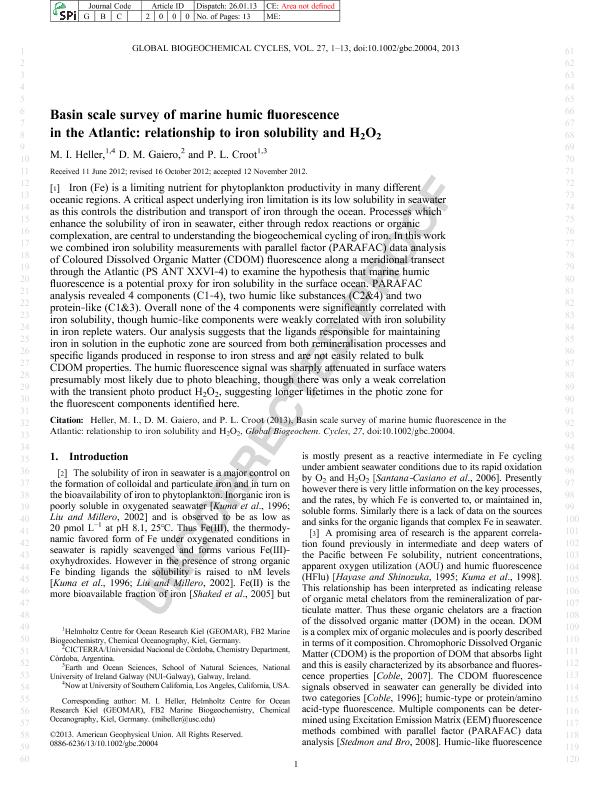Mostrar el registro sencillo del ítem
dc.contributor.author
Heller, M. I.
dc.contributor.author
Gaiero, Diego Marcelo

dc.contributor.author
Croot, P. L.
dc.date.available
2017-09-29T19:28:22Z
dc.date.issued
2013-02
dc.identifier.citation
Heller, M. I.; Gaiero, Diego Marcelo; Croot, P. L.; Basin scale survey of marine humic fluorescence in the Atlantic: relationship to iron solubility and H2O2; American Geophysical Union; Global Biogeochemical Cycles; 27; 1; 2-2013; 88-100
dc.identifier.issn
0886-6236
dc.identifier.uri
http://hdl.handle.net/11336/25459
dc.description.abstract
Iron (Fe) is a limiting nutrient for phytoplankton productivity in many different oceanic regions. A critical aspect underlying iron limitation is its low solubility in seawater as this controls the distribution and transport of iron through the ocean. Processes which enhance the solubility of iron in seawater, either through redox reactions or organic complexation, are central to understanding the biogeochemical cycling of iron. In this work we combined iron solubility measurements with parallel factor (PARAFAC) data analysis of Coloured Dissolved Organic Matter (CDOM) fluorescence along a meridional transect through the Atlantic (PS ANT XXVI-4) to examine the hypothesis that marine humic fluorescence is a potential proxy for iron solubility in the surface ocean. PARAFAC analysis revealed 4 components (C1-4), two humic like substances (C2&4) and two protein-like (C1&3). Overall none of the 4 components were significantly correlated with iron solubility, though humic-like components were weakly correlated with iron solubility in iron replete waters. Our analysis suggests that the ligands responsible for maintaining iron in solution in the euphotic zone are sourced from both remineralisation processes and specific ligands produced in response to iron stress and are not easily related to bulk CDOM properties. The humic fluorescence signal was sharply attenuated in surface waters presumably most likely due to photo bleaching, though there was only a weak correlation with the transient photo product H2O2, suggesting longer lifetimes in the photic zone for the fluorescent components identified here.
dc.format
application/pdf
dc.language.iso
eng
dc.publisher
American Geophysical Union

dc.rights
info:eu-repo/semantics/openAccess
dc.rights.uri
https://creativecommons.org/licenses/by-nc-sa/2.5/ar/
dc.subject
Hierro
dc.subject
Oceano Atlántico
dc.subject
Cdom
dc.subject
Fitoplankton
dc.subject.classification
Oceanografía, Hidrología, Recursos Hídricos

dc.subject.classification
Ciencias de la Tierra y relacionadas con el Medio Ambiente

dc.subject.classification
CIENCIAS NATURALES Y EXACTAS

dc.title
Basin scale survey of marine humic fluorescence in the Atlantic: relationship to iron solubility and H2O2
dc.type
info:eu-repo/semantics/article
dc.type
info:ar-repo/semantics/artículo
dc.type
info:eu-repo/semantics/publishedVersion
dc.date.updated
2017-09-28T19:03:16Z
dc.journal.volume
27
dc.journal.number
1
dc.journal.pagination
88-100
dc.journal.pais
Estados Unidos

dc.description.fil
Fil: Heller, M. I.. Geomar-Helmholtz Centre for Ocean Research Kiel; Alemania
dc.description.fil
Fil: Gaiero, Diego Marcelo. Consejo Nacional de Investigaciones Científicas y Técnicas. Centro Científico Tecnológico Conicet - Córdoba. Centro de Investigaciones en Ciencias de la Tierra. Universidad Nacional de Córdoba. Facultad de Ciencias Exactas Físicas y Naturales. Centro de Investigaciones en Ciencias de la Tierra; Argentina
dc.description.fil
Fil: Croot, P. L.. Geomar-Helmholtz Centre for Ocean Research Kiel; Alemania
dc.journal.title
Global Biogeochemical Cycles

dc.relation.alternativeid
info:eu-repo/semantics/altIdentifier/doi/http://dx.doi.org/10.1029/2012GB004427
dc.relation.alternativeid
info:eu-repo/semantics/altIdentifier/url/http://onlinelibrary.wiley.com/doi/10.1029/2012GB004427/abstract
Archivos asociados
